-
 This was a meeting between Truman, Stalin, and Churchill. During this conference: Germany was demilitarized, reparations were discussed, punishment of Nazi criminals was decided, unconditional surrender of Japan was demanded, and the future of Eastern Europe was discussed.
This was a meeting between Truman, Stalin, and Churchill. During this conference: Germany was demilitarized, reparations were discussed, punishment of Nazi criminals was decided, unconditional surrender of Japan was demanded, and the future of Eastern Europe was discussed. -
 Yalta Conference was a meeting between FDR, Churchill, and Stalin. During this conference: Germany was divided into 4 occupation zones, the United Nations was established, the USSR agreed to enter the war against Japan, and Poland was allowed free elections.
Yalta Conference was a meeting between FDR, Churchill, and Stalin. During this conference: Germany was divided into 4 occupation zones, the United Nations was established, the USSR agreed to enter the war against Japan, and Poland was allowed free elections. -
 The Long Telegram was George Kennan's analysis of the Soviet Union. It was the beginning of the policy of containment, which shaped America's behavior during the Cold War. The telegram was sent initially to the Secretary of State, but it was widespread enough that it got leaked to the Soviet Union. The Long Telegram essentially stated the Soviet Union was an expansionist country.
The Long Telegram was George Kennan's analysis of the Soviet Union. It was the beginning of the policy of containment, which shaped America's behavior during the Cold War. The telegram was sent initially to the Secretary of State, but it was widespread enough that it got leaked to the Soviet Union. The Long Telegram essentially stated the Soviet Union was an expansionist country. -
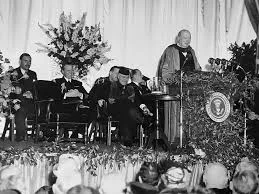 The "Iron Curtain" speech was delivered by Winston Churchill. In the speech, Churchill famously declared that an "Iron Curtain" had descended across Europe, dividing the continent into the Soviet-controlled East and the Western democracies. He highlighted the growing threat of Soviet influence and the spread of communism, calling for greater unity among Western nations to resist Soviet expansion.
The "Iron Curtain" speech was delivered by Winston Churchill. In the speech, Churchill famously declared that an "Iron Curtain" had descended across Europe, dividing the continent into the Soviet-controlled East and the Western democracies. He highlighted the growing threat of Soviet influence and the spread of communism, calling for greater unity among Western nations to resist Soviet expansion. -
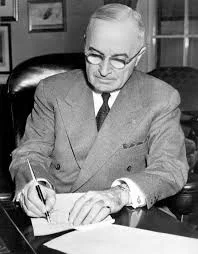 The Truman Doctrine was a policy established by Harry S. Truman. It committed the United States to support democracy. The Doctrine stated that the United States would support countries fighting against communism. This was an active shift to contain communism. The support included political, military, and economic aid. This was a solidifying of the policy of containment.
The Truman Doctrine was a policy established by Harry S. Truman. It committed the United States to support democracy. The Doctrine stated that the United States would support countries fighting against communism. This was an active shift to contain communism. The support included political, military, and economic aid. This was a solidifying of the policy of containment. -
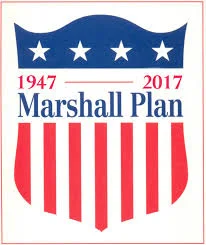 The Marshall Plan was a program to provide economic aid to Europe after WWII. It provided aid to countries to rebuild after the war. The plan provided capital and materials to rebuild goods. They wanted to have these countries become stable partners to the United States. This helped promote democracy by showing how great a country the US was. There were no terms applied. This offer was extended to every country, through the Soviet bloc denied help.
The Marshall Plan was a program to provide economic aid to Europe after WWII. It provided aid to countries to rebuild after the war. The plan provided capital and materials to rebuild goods. They wanted to have these countries become stable partners to the United States. This helped promote democracy by showing how great a country the US was. There were no terms applied. This offer was extended to every country, through the Soviet bloc denied help. -
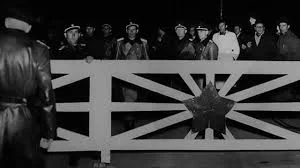 The Berlin Blockade occurred from June 1948 to May 1949, when the Soviet Union blocked all land and water routes to West Berlin, which was controlled by the United States, Britain, and France. The Soviets aimed to force the Allies out of the city and gain control over all of Berlin, which was located deep within Soviet-controlled East Germany. The blockade lasted for nearly a year before the Soviets lifted it, but it intensified Cold War tensions between the Soviet Union and the Western Allies.
The Berlin Blockade occurred from June 1948 to May 1949, when the Soviet Union blocked all land and water routes to West Berlin, which was controlled by the United States, Britain, and France. The Soviets aimed to force the Allies out of the city and gain control over all of Berlin, which was located deep within Soviet-controlled East Germany. The blockade lasted for nearly a year before the Soviets lifted it, but it intensified Cold War tensions between the Soviet Union and the Western Allies. -
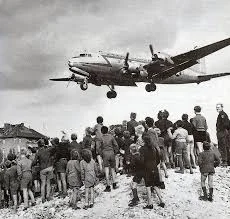 The Berlin Airlift was a response to the Soviet Union's Berlin Blockade. When the Soviets blocked all land and water access to West Berlin, the U.S. and its allies organized a massive airlift to supply the city with food, fuel, and other essentials. Over 275,000 flights were made by Western planes, delivering vital supplies to more than two million residents of West Berlin. The airlift demonstrated the Allies' commitment to defending Berlin and countering Soviet pressure.
The Berlin Airlift was a response to the Soviet Union's Berlin Blockade. When the Soviets blocked all land and water access to West Berlin, the U.S. and its allies organized a massive airlift to supply the city with food, fuel, and other essentials. Over 275,000 flights were made by Western planes, delivering vital supplies to more than two million residents of West Berlin. The airlift demonstrated the Allies' commitment to defending Berlin and countering Soviet pressure. -
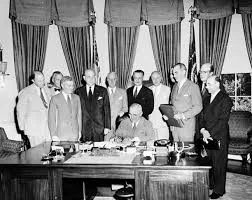 NATO is a military alliance. Its primary goal is to ensure the security and defense of its member countries against external threats, particularly during the Cold War in response to the Soviet Union. The alliance initially consisted of 12 countries, including the United States, Canada, and several Western European nations. NATO's collective defense principle states that an attack on one member is considered an attack on all. Over time, NATO has expanded to include countries from Eastern Europe.
NATO is a military alliance. Its primary goal is to ensure the security and defense of its member countries against external threats, particularly during the Cold War in response to the Soviet Union. The alliance initially consisted of 12 countries, including the United States, Canada, and several Western European nations. NATO's collective defense principle states that an attack on one member is considered an attack on all. Over time, NATO has expanded to include countries from Eastern Europe. -
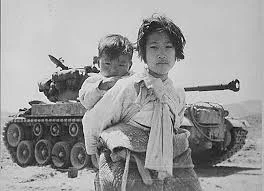 The Korean War began when North Korean forces invaded South Korea. The conflict arose from the division of Korea after World War II, with the North being backed by the Soviet Union and China, and the South being supported by the United States. The NK forces pushed the SK forces to Pusan. General McCarthy pushed NK back to the Chinese border. The war became a stalemate near the 38th parallel. In 1953, an armistice was signed. This was a proxy war.
The Korean War began when North Korean forces invaded South Korea. The conflict arose from the division of Korea after World War II, with the North being backed by the Soviet Union and China, and the South being supported by the United States. The NK forces pushed the SK forces to Pusan. General McCarthy pushed NK back to the Chinese border. The war became a stalemate near the 38th parallel. In 1953, an armistice was signed. This was a proxy war. -
 ICBM testing refers to the testing of Intercontinental Ballistic Missiles (ICBMs), which are long-range missiles capable of carrying nuclear warheads across continents. The first successful ICBM test was conducted by the Soviet Union in 1957, during the height of the Cold War. The United States followed shortly after, testing its ICBMs. These tests were seen as a demonstration of technological and military power, with both superpowers trying to outpace each other in missile development.
ICBM testing refers to the testing of Intercontinental Ballistic Missiles (ICBMs), which are long-range missiles capable of carrying nuclear warheads across continents. The first successful ICBM test was conducted by the Soviet Union in 1957, during the height of the Cold War. The United States followed shortly after, testing its ICBMs. These tests were seen as a demonstration of technological and military power, with both superpowers trying to outpace each other in missile development. -
 Sputnik was the first artificial Earth satellite, launched by the Soviet Union on October 4, 1957. The satellite orbited the Earth and transmitted radio signals, marking a significant milestone in the Space Race. Its successful launch shocked the world, especially the United States, and led to fears of Soviet technological superiority. In response, the U.S. created NASA in 1958. Sputnik's launch marked the beginning of the Cold War space competition between the U.S. and the USSR.
Sputnik was the first artificial Earth satellite, launched by the Soviet Union on October 4, 1957. The satellite orbited the Earth and transmitted radio signals, marking a significant milestone in the Space Race. Its successful launch shocked the world, especially the United States, and led to fears of Soviet technological superiority. In response, the U.S. created NASA in 1958. Sputnik's launch marked the beginning of the Cold War space competition between the U.S. and the USSR. -
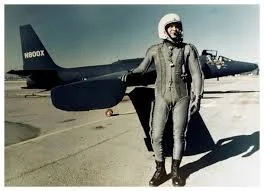 The U-2 plane incident occurred when a U.S. spy plane, piloted by Gary Powers, was shot down over Soviet airspace. The U-2 was spying on Soviet missile sites. The Soviet Union, led by Khrushchev, captured Powers and revealed the incident, embarrassing the United States. The incident severely damaged U.S.-Soviet relations and led to the collapse of a planned summit between Eisenhower and Khrushchev. Powers became hated because he did not self-destruct the plane or take his cyanide capsule.
The U-2 plane incident occurred when a U.S. spy plane, piloted by Gary Powers, was shot down over Soviet airspace. The U-2 was spying on Soviet missile sites. The Soviet Union, led by Khrushchev, captured Powers and revealed the incident, embarrassing the United States. The incident severely damaged U.S.-Soviet relations and led to the collapse of a planned summit between Eisenhower and Khrushchev. Powers became hated because he did not self-destruct the plane or take his cyanide capsule. -
 The Bay of Pigs invasion was when a group of Cuban exiles, supported by the CIA, attempted to overthrow Fidel Castro's government in Cuba. The invasion force landed at the Bay of Pigs but was quickly met with strong resistance from Cuban forces. The operation was poorly planned, and the exiles were defeated within three days. President John F. Kennedy, who had authorized the mission, backed away from naval or air support. This led to a humiliating defeat of the exiles and worsened ties.
The Bay of Pigs invasion was when a group of Cuban exiles, supported by the CIA, attempted to overthrow Fidel Castro's government in Cuba. The invasion force landed at the Bay of Pigs but was quickly met with strong resistance from Cuban forces. The operation was poorly planned, and the exiles were defeated within three days. President John F. Kennedy, who had authorized the mission, backed away from naval or air support. This led to a humiliating defeat of the exiles and worsened ties. -
 The Cuban Missile Crisis was when the U.S. discovered Soviet nuclear missiles in Cuba, just 90 miles from Florida. Tensions reached a peak as both superpowers braced for potential nuclear war. President John F. Kennedy imposed a naval blockade and demanded the removal of the missiles. Soviet leader Nikita Khrushchev agreed to dismantle the missiles in exchange for a U.S. pledge not to invade Cuba and the secret removal of U.S. missiles in Turkey.
The Cuban Missile Crisis was when the U.S. discovered Soviet nuclear missiles in Cuba, just 90 miles from Florida. Tensions reached a peak as both superpowers braced for potential nuclear war. President John F. Kennedy imposed a naval blockade and demanded the removal of the missiles. Soviet leader Nikita Khrushchev agreed to dismantle the missiles in exchange for a U.S. pledge not to invade Cuba and the secret removal of U.S. missiles in Turkey.
